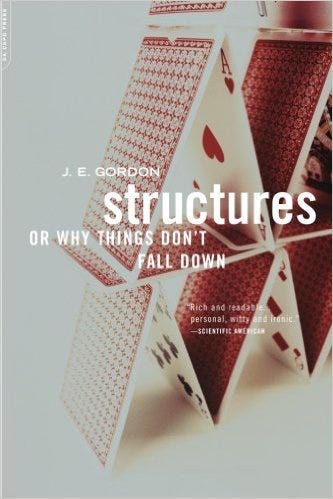Learn what holds structures together and gain interesting insight in material engineering

What are structures? A structure is a collection of materials intended to sustain loads. Structures occur in nature as well as in the man-made world.
Biological structures are a product of nature’s evolution. Our bodies, for example, consist of structures like bones and muscle tissue, flower petals are, and tree bark is other examples of natural structures.
Artificial, man-made structures began not that long ago. The modern study of structures began with in the seventeenth century when Galileo switched his career — due to threats from the Catholic Church — from astronomy to the study of the character of physical materials.
Robert Hooke also started to work on the subject in the same century. He discovered that one fundamental principle of structures is that they have to push back with force proportional to the weight it has to support.
Stress and strain
Stress measures the force by which atoms and molecules within the material are being pushed apart, and it is measured as a function of force and area. In other words, stress is measured by dividing a force or pressure by the area it’s acting upon, aka newtons area.
Strain, on the other hand, describes how far atoms of the material are being pushed apart.
Strain is a function of the length of an object after applying the force, with its original length.
Stiffness, aka Young’s modulus of elasticity, measures the elasticity of a material under stress and is a function of the other two properties. It defines the relationship between stress (force per unit area) and strain (proportional deformation) in a material.
Compression forces are more durable than tensile forces
It’s not a coincidence that our ancestors built churches, castles and other monuments based on compression. They knew that it was best to avoid tensile forces and preferably use compressive forces. Compression structures rarely collapse due to high stress such as tension structures. They only tend to fall when there is a lack of stability or through shearing. Shearing happens when one part of a material slides past another when the shearing becomes critical it can cause a collapse. Collapse from compression is called compression failure and usually happens when shearing occurs at a 45 degree.
The beam takes advantage of compressive force
Building a roof represents a challenge. The roof exerts outward pressure on the walls, even more so when there are windows. Beams solve this by redirecting the pressure from the ceiling downwards and away from the walls. In other words, force is directed downwards not horizontally on the supporting elements.
Creep is a permanent deformation of materials
Creep, (sometimes called cold flow) is the tendency of a solid material to deform permanently under the influence of mechanical stresses, like tension or compression.
When those new shoes you bought become more comfortable after some weeks of wearing them, it is a result of creep. The areas of the shoes subject to most physical stress change so that the stress becomes more even or balanced across the surface.
Cracks, material problems and irregularities
Cracks can be dangerous if they reach a critical length. The critical length is called Griffith crack length. Once a crack reaches a critical length the structure puts more and more stress on the remaining material, causing the crack to grow even faster thus eventually leading to a potential collapse of the structure.
Material problems are another reason why structures collapse. In 1913 C. E. Inglis wrote about this in his book about irregularities within a material. The problem with irregularities is that they can cause an uneven or local stress on materials. Holes, cracks, and sharp corners are some potential causes of local stress on materials.
Irregularities can be caused if a patch has another material property than the material it is added to. A thick patch on a piece of thin clothing could tear it even more on the edges of the patch for example.
Fatigue is another problem for materials such as metal. Fatigue occurs when a heavy load is applied to metal with varying intensity, causing fluctuations. Metal fatigue is so hard to spot that nowadays complex statistics are employed to calculate the probability of fatigue occurrence. These calculations were developed by doing a lot of experimentation. Between 1935 and 1955 around 100 types of airplanes were built to test their structural robustness.
Why I would recommend this book to you: This book will give you a nice journey through the history and development of structures. This is one of Elon Musk’s favorite books, probably due to his interest in car and rocket structures, which motivated me to read it.
